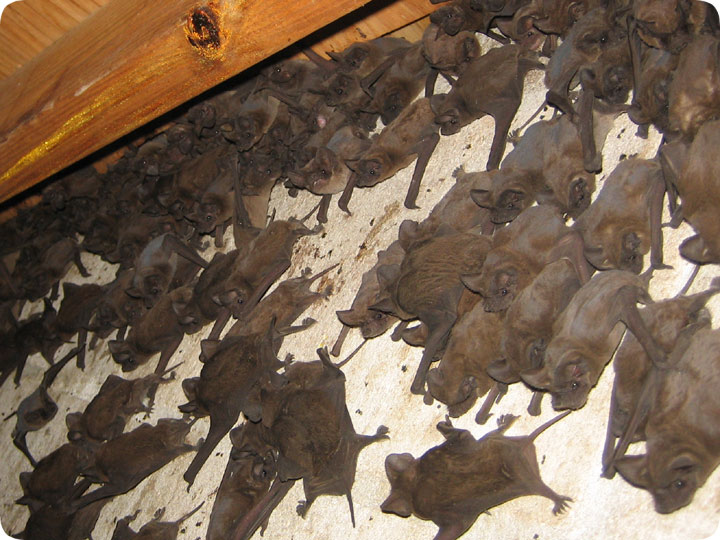-
info@aaanimalcontrol.com
Call us for help in your town
Humane Wildlife Education
Giant Bat Colony In the Attic

And smell - more than 30' of attic was coated with bat droppings, up to a foot deep. In fact, the ceiling below was starting to crack and collapse. It was situated right above the head of the homeowner's bed. I think I'd enjoy seeing the ceiling collapse in a shower of guano on the old dude's head. Not because I'm sadistic, it's just that like anyone, I enjoy a good poop-on-the-head gag - a traditional and time tested comedy staple dating back to ....monkeys, I believe, who still get kicks out of poop-on-the-head practical jokes. Joking aside, I believe that he was able to tolerate the smell and the noise coming from upstairs for so many years due to senses compromised by age. However, with the traditional August ruckus that accompanies the new young bats, who are just starting to fly, I guess he said, "enough is enough", and called me in to take care of the problem. As usual, I am in the process of removing each and every bat without harming a single one. All will find new homes to live in, preferably not inside the attic of a house, right above a fellow's head.
08.21.06 - UPDATE: I have successfully removed the entire group, sealed the building (with guarantee) against any future bat entry, and most importantly, removed all the guano from the attic, and decontaminated and deodorized
the entire area. No more noise, no more smell. I do have to say though, the walls inside the attic look somewhat boring not covered with two thousand scurrying, chattering bats.
Do it yourself: Visit my How To Get Rid of Bats page for tips and advice.
Get professional help: Visit my Nationwide Pro Directory of wildlife removal experts.
For more wildlife stories, click my Wildlife Blog
or click my below banner to hire a local trapper.
If you have found a bat colony in your home or living around your home, you were probably led there by the horrible smell that comes from the colony staying there. The feces will be found in piles and they are extremely pungent.
Bats like dark places where they can rest and raise a family and your attic fits the bill. When they try to find other places, they may not get the peace and quiet that your attic provides, and it’s also great at keeping them protected from the weather. Their babies can be born and then raised in a shelter that is fit for protection from any predators that may be searching for them. Unfortunately, having a colony of them living so close to you can be extremely hazardous for your health. They carry respiratory diseases that can transfer over to humans simply by inhaling the spores found within their feces.
Once you discover the bat colony, you will not only need to remove the bats from the location, but you will also need to clean up the mess they leave behind. Then you will have to take preventive measures in order to get rid of them for good.
Signs to look for that indicate bats are living in or around your home
The signs are not always clear but most of the time, you can solve the mystery if you have one or more of the following present:
Piles of poop in one particular location - usually because bats will attach themselves to the roof when staying in so when they poop, it lands in one pile
A greasy film-like substance that is brown in color can be seen around the cracks going into the roof or attic from the outside
You hear a squeaking sound in or around your home
You smell an ammonia type smell close to your home
You see bats inside your home
You see dead bats outside or inside your home
Your pet cat or dog is bringing in bats
What to do if you notice these signs
When you notice that bats are around or inside your home, it's important that you watch them for a day or two to figure out where they are coming in and out of and how many you estimate to be there.
The next thing you will want to do is to hire a professional, especially if you suspect that there is a colony that is active in or near your home. It takes planning and patience to remove the bats from a location and a professional knows how to do that.
Once the bats are removed from your home, you will want to take preventative measures to ensure that they are gone and there is no way they can return.
Twice a year, walk around your home, searching carefully to see if you notice any bats going in and out of the top of the home. If so, you may need to call the professionals back or you may want to try and seal up the area before they reproduce, and the colony grows back.




















